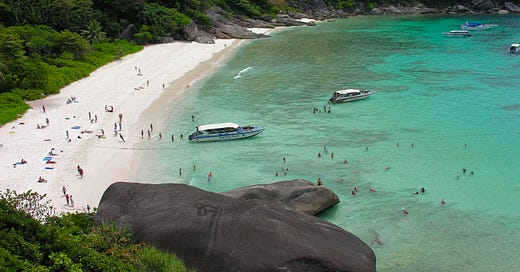T.I.C.D.: Mu Ko Similan & Mu Ko Surin
Two of Thailand's most spectacular island chains, condensed.
Welcome back to the Thai Island & Coastal Directory, covering 1,000+ islands and 300+ shorelines across all 24 coastal provinces. An upgrade gets you the T.I.C.D. and many other in-depth articles from Thai Island Quest.
T.I.C.D. ticker: So far, we’ve covered 1,125 islands and 338 notable coastal areas in 61 sections of the Thai Island & Coastal Directory.
To view all previously published sections, see the welcome page or the working Table of Contents, or click T.I.C.D. from the homepage menu.
Resuming Phang Nga province…
This section begins the islands and coastal areas in proximity to Phang Nga’s W coast in the Northern Andaman coastal zone. If you are looking for Phang Nga province’s S reaches, they are folded into the Central Andaman via 3 sections on Ao Phang Nga: the bay’s coastal areas including Mueang Phang Nga; the bay’s upper islands; and its lower island groups of Mu Ko Yao and Mu Ko Hong.
Combine Ao Phang Nga with the islands off the province’s W coast, including Mu Ko Surin and Mu Ko Similan as well as Ko Phra Thong and others found closer to the mainland shores, and Phang Nga tallies at least 170 islands in total, making it the second most island-rich province in Thailand after Krabi.
Islands below are arranged roughly from S to N.
Mu Ko Similan
This delicate chain of 9 islands ranks among Thailand’s most spectacular thanks to its abundant reefs, powder-blue water and white sand gracing coves backed by towering boulders. The Similans are remote — 70 km off the coast of mainland Phang Nga province — but this does not stop crowds from venturing to them from the major tourism centers of Khao Lak and Phuket.
The entire Similan chain joins Ko Tachai and Ko Bon under Mu Ko Similan NP, and it is easy to imagine the island of Ko Similan being heavily developed for tourism had it not been protected during a 1970s and ‘80s push to conserve unsettled areas of Thai islands. Unlike Mu Ko Ang Thong and Mu Ko Samet, to name two examples where previous inhabitation led to some private development that now co-exists with the NPs, Mu Ko Similan’s lack of ancestral land rights made it one of the only Thai island groups that still has no private development of any kind.
But while overcrowding was never as egregious as on Ko Phi Phi Leh, for instance, the Similans faced similar challenges when — by the mid 2010s — upwards of 7,000 travelers arrived daily during dry season. Authorities started pushing back in 2016, ultimately limiting daily visitors to 3,325 (at least in theory) and disallowing overnight stays at the NP-run lodgings and campground that operated on Ko Miang until 2018. Long before then, Ko Huyong and Mu Ko Similan’s other 2 southernmost islands were made off limits to tourist traffic. Still, keep in mind that the current daily quota is not exactly a small number of people for such tiny islands.
Apart from those joining live-aboard scuba trips that launch from as far off as Ko Lanta and Ranong and anchor at some 25 dive sites within Mu Ko Similan, nearly all visitors arrive via speedboats on tours that include snorkeling along with fleeting stops for relaxing and hiking on Ko Similan and Ko Miang.
The closest departure point for such tours is Tha Thap Lamu, a pier that sits next to the park’s main visitor center just S of Khao Lak. Some tours also launch from Tha Patong in Phuket some 90 km to the S, making for a longer ride. To avoid missing out at peak times of year, secure tickets to the Similans at least a few days in advance, be it online or in person from a travel shop or boat company office. Mu Ko Similan NP closes for rainy season from May 15th to October 15th.
If the Similans sound too touristy for you, consider skipping them in favor of Mu Ko Surin (covered below), which is also marvelous and has the advantages of NP-run accommodations and locally based longtail boats.
Ko Huyong: Small island | Alt. name: ‘Nueng’ | S end of Mu Ko Similan | Fully closed by NP | Brilliant beach; Extensive offshore reef; Forested | Uninhabited | Wildlife interest (sea turtle nesting)




